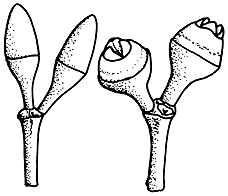Common name: Slaty Red Gum
Eucalyptus glaucina (Blakely) L.A.S.Johnson APNI* Synonyms: Eucalyptus umbellata var. glaucina Blakely APNI*

Description: Tree to 30 m high; bark smooth and often powdery, white or grey, shedding in large plates or flakes.
Juvenile leaves disjunct, ovate, glaucous. Young branchlets usually winged to angled.
Adult leaves disjunct, lanceolate, 12–18 cm long, 2–3 cm wide, green or grey-green, dull, concolorous. Umbellasters 7-flowered; peduncle terete or 4-angled, 12–20 mm long; pedicels terete, 2–5 mm long. Buds fusiform, glaucous, 8–15 mm long, 5–6 mm diam., scar present; calyptra conical or elongate acute, longer than and as wide as hypanthium. Flowering branchlets often angled.
Fruit globose or ovoid, 3–5-locular, 7–10 mm long, 7–10 mm diam.; disc raised; valves exserted.
Distribution and occurrence: Locally frequent but very sporadic, in grassy woodland on deep, moderately fertile and well-watered soil; known from near Casino in the north, Taree to Broke in the Hunter region, and from around Lake Burragorang in the south.
NSW subdivisions: NC, CC
Threatened species: NSW BCA: Vulnerable; Commonwealth EPBC: Vulnerable
Text by K. Hill. (Edited by A.E. Orme, Jul 2025).
Taxon concept: Flora of NSW 2 (1991)
APNI* Provides a link to the Australian Plant Name Index (hosted by the Australian National Botanic Gardens) for comprehensive bibliographic data
***The AVH map option provides a detailed interactive Australia wide distribution map drawn from collections held by all major Australian herbaria participating in the Australian Virtual Herbarium project.
|


